Transport in India- 1 | General Awareness - Bank Exams PDF Download
| Table of contents |

|
| Transport |

|
| Air Transportation |

|
| Water Transport |

|
| Road Transport in India |

|
| Indian Railways |

|
Transport
Transport is necessary for moving goods and services from where they are produced to where they are needed. Traders play a crucial role in this process by facilitating transportation. The development of a country depends on both the production of goods and services and their movement across different areas. Therefore, having efficient transport systems is essential for rapid development.Goods and services can be moved across three main domains of the earth:
- Land
- Water
- Air
Based on these domains, transport is classified into land, water, and air transport.
Air Transportation
- Speed and Efficiency: Air transport is the quickest way to move people and goods from one place to another. It has significantly reduced travel times and distances, making it essential for a vast and diverse country like India, where distances are large and the terrain and climate vary greatly.
- Historical Background: Air transport in India began in 1911 with airmail operations over a short distance of 10 km between Allahabad and Naini. However, it saw significant development after India gained independence.
- Regulatory Authority: The Airport Authority of India (AAI) is responsible for ensuring safe and efficient air traffic and aeronautical communication services within Indian airspace.
- Helicopter Services: Pawan Hans is a helicopter service that operates in hilly areas of India. It is widely used by tourists, especially in the northeastern region of the country.
List of Indian Airports (Domestic and International)
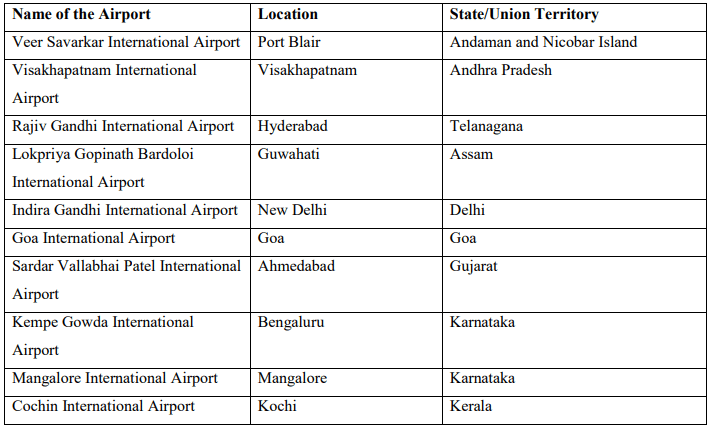
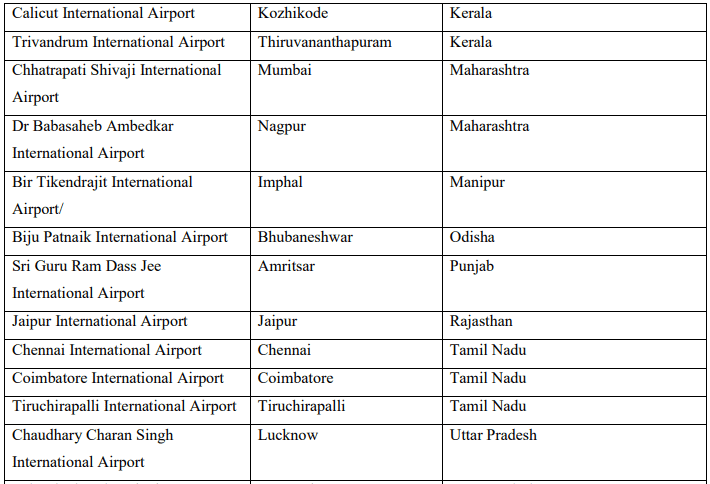
Water Transport
Water transport is a crucial mode of transportation for both passengers and cargo in India. It is the most economical means of transport, particularly suitable for carrying heavy and bulky materials. Additionally, water transport is fuel-efficient and environmentally friendly. There are two main types of water transport:
(a) Inland Waterways
(b) Oceanic Waterways
Inland National Waterways of India
The Inland Waterways Authority of India was established in 1986 to develop, maintain, and regulate the national inland waterways in the country.
NW-1 (Ganga-Bhagirathi Hooghly River System)
- Route: Prayagraj to Haldia
- Length: 1620 km
NW-2 (Brahmaputra River System)
- Route: Sadiya to Dhubri
- Length: 891 km
NW-3 (West Coast Canal, Champakara Canal, and Udyogamandal Canal)
- Route: Kottapuram to Kollam
- Length: 205 km
NW-4 (Krishna and Godavari River System)
- Route: Kakinada to Marakkanam
- Length: 1095 km
NW-5 (Mahanadi and Brahmini River System)
- Route: Magalgarhi to Pradeep and Talcher to Dhamra
- Length: 623 km
Kerala's backwaters (known as Kadal) play an important role in Inland Waterway transport.
These backwaters offer a cost-effective way to travel.
They also draw a significant number of tourists to Kerala.
One of the major attractions is the Nehru Trophy Boat Race, also called Vallamkali, which takes place in these backwaters.
Oceanic Routes
- India has a long coastline of about 7,517 km, including its islands. There are 13 major ports and 185 minor ports supporting these oceanic routes.
- Oceanic routes are crucial for India's transport sector, handling around 95% of foreign trade by volume and 70% by value.
- These routes are not only for international trade but also for transporting goods between the islands and the mainland.
Major Ports in India
- Kandla Port (Deendayal Port):
- Developed post-Independence to alleviate trade pressure on Mumbai port.
- Became important after India lost Karachi port to Pakistan.
- Tidal port facilitating exports and imports for a productive region including Jammu and Kashmir, Himachal Pradesh, Punjab, Haryana, Rajasthan, and Gujarat.
Chennai Port:
- One of the oldest artificial ports in India.
- Ranks second to Mumbai in trade volume and cargo handling.
Vishakhapatnam Port:
- Deepest landlocked and well-protected port in India.
- Initially envisioned as an outlet for iron ore exports.
Paradip Port:
- Located in Odisha, specializing in iron ore exports.
Kolkata Port:
- An inland riverine port serving the Ganga-Brahmaputra basin.
- Requires constant dredging of the Hooghly River due to its tidal nature.
Haldia Port:
- Developed as a subsidiary to Kolkata port to manage increasing pressure and traffic.
Mumbai Port:
- The largest port in India, featuring a spacious and well-sheltered natural harbour.
Jawaharlal Nehru Port:
- Planned to decongest Mumbai port and serve as a regional hub.
Marmagao Port:
- Located in Goa, it is the leading iron ore exporting port in India.
- Accounts for about 50% of the country’s iron ore exports.
New Mangalore Port:
- Situated in Karnataka, it exports iron ore concentrates from the Kudremukh mines.
Kochi Port:
- Located in the extreme southwestern part of India, at the entrance of a lagoon with a natural harbour.
List of Important Ports in India
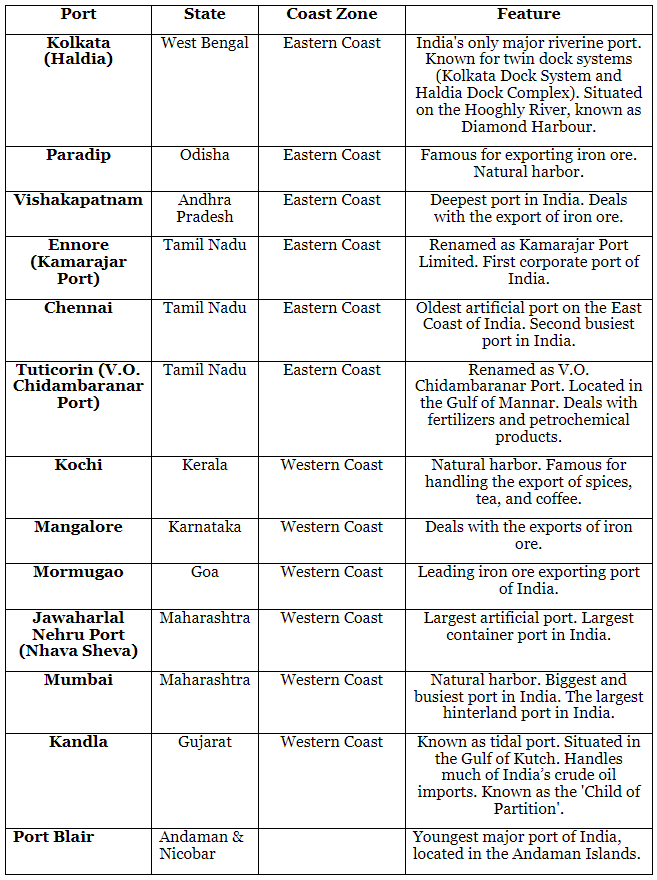
Road Transport in India
- India boasts the second-largest road network in the world, spanning approximately 58.98 lakh km.
- Before World War II, road transport in India was quite limited. The first significant effort to improve it was the "Nagpur Plan" in 1943, but this plan failed due to a lack of coordination between the princely states and British India.
- After gaining independence, India introduced a twenty-year road plan in 1961 to enhance road conditions across the country.
- Roads in India are classified into several categories: National Highways (NH), State Highways (SH), Major District Roads, and Rural Roads.
Grand Trunk Road:
- The Grand Trunk Road, originally built by Sher Shah Suri to connect and strengthen his empire from the Indus Valley to Bengal, was later renamed during British rule.
- Today, this historic road extends from Amritsar to Kolkata and is divided into two main segments: (a) National Highway (NH)-1 from Delhi to Amritsar(b) NH-2 from Delhi to Kolkata.
National Highways:
- The National Highways Authority of India (NHAI) was established in 1995 as an autonomous body under the Ministry of Surface Transport. Its main responsibility is the development, maintenance, and operation of National Highways. NHAI is also the apex body for improving the quality of roads designated as National Highways.
- National Highways make up only 2.7% of the total road length in India but carry about 40% of the road traffic.
- The Golden Quadrilateral is a major project comprising National Highways that connect the four metro cities of Delhi, Mumbai, Chennai, and Kolkata, with a total length of 5,846 km.
- The North-South Corridor aims to connect Srinagar in Jammu and Kashmir with Kanniyakumari in Tamil Nadu, covering a distance of 4,076 km. The East-West Corridor plans to connect Silchar in Assam with Porbandar in Gujarat, spanning 3,640 km.
State Highways:
- State Highways are roads that connect a state capital with various district headquarters within the state. These roads are constructed and maintained by the State Public Works Department (PWD) in States and Union Territories.
District Roads:
- District Roads are responsible for connecting the district headquarters with other areas within the district. These roads are maintained by the Zila Parishad, the local governing body at the district level.
Rural Roads:
- Rural Roads link rural areas and villages with towns. This category of roads has received special attention under the Pradhan Mantri Grameen Sadak Yojana, which aims to connect every village in the country to a major town by an all-season motorable road.
Border Roads:
- The Border Road Organisation (BRO) was established in May 1960 to accelerate economic development and strengthen defence preparedness by improving strategically important roads along India’s northern and northeastern borders. BRO is a premier construction agency known for its work in challenging terrains.
- BRO has successfully constructed roads in high-altitude mountainous areas, such as the routes connecting Chandigarh with Manali in Himachal Pradesh and Leh in Ladakh. These roads average an altitude of 4,270 meters above sea level.
The World‟s longest Highway tunnel-Atal Tunnel (9.02 Km) has been built by Border Road Organisation. This tunnel connects Manali to Lahul-Spiti valley throughout the year. Earlier the valley was cut off for about 6 months each year owing to heavy snowfall. The tunnel is buit with ultra-modern specifications in the Pir Panjal range of Himalayas at an altitude of 3000 metres from the Mean Sea Level (MSL).
Here's a table summarizing the important National Highways of India, their routes, and distances:
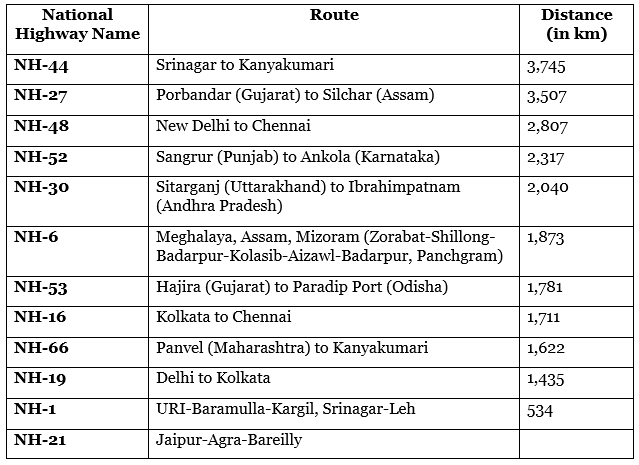
Indian Railways
It is one of the largest and longest railway networks in the world, playing a crucial role in the movement of goods and people across the country. It is a significant contributor to India's economic growth. Mahatma Gandhi once remarked that Indian Railways helped unite people from diverse cultures, which was vital for India's freedom struggle. Here are some key points about Indian Railways: - Indian Railways is the largest public sector undertaking in India. - The first train in India ran from Mumbai to Thane in 1853, covering a distance of 34 kilometers. - This railway line was built during the administration of Lord Dalhousie. - The total length of the Indian Railways network is approximately 67,368 kilometers.There are different types of railway gauges in India: -
Broad Gauge. The distance between the rails is 1.676 meters. -
Metre Gauge. The distance between the rails is 1 meter. -
Narrow Gauge. The distance between the rails is either 0.762 meters or 0.610 meters.
The Konkan Railway, completed in 1998, is a remarkable achievement of the Indian Railways. This 760-kilometer long route connects Roha in Maharashtra to Mangalore in Karnataka. It is considered an engineering marvel as it crosses 146 rivers and streams, features nearly 2000 bridges, and includes 91 tunnels. The states of Maharashtra, Goa, and Karnataka collaborated on this project. Some notable features of Indian Railways include:
Gorakhpur Railway Station, which has the world's longest railway platform.
Mumbai, home to the busiest suburban railway network in India.
Vivek Express, which runs from Dibrugarh to Kanyakumari, is the longest train route in the Indian subcontinent.
Ahmedabad-Mumbai Central Double Decker Express, India’s first double-decker train.
Surekha Shankar Yadav, the first female loco pilot in Indian Railways. The railway network is organized into 17 zones for efficient management and operation.
The 17 zones are their respective headquarters are given below: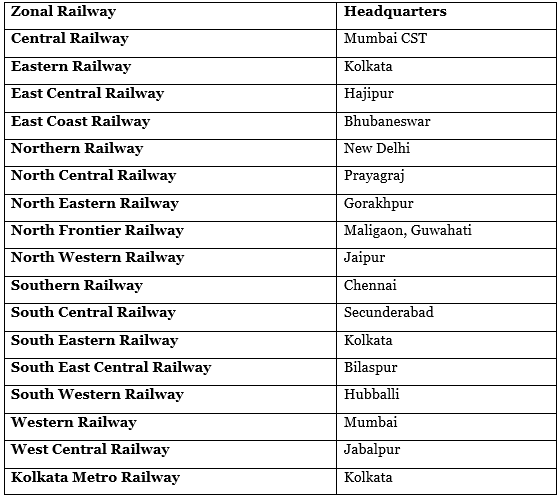
Railway Production Units

|
365 videos|700 docs|149 tests
|
FAQs on Transport in India- 1 - General Awareness - Bank Exams
| 1. What is the significance of Indian Railways in the economy of India? |  |
| 2. How has the development of roadways contributed to the growth of India? |  |
| 3. What are the different classifications of roads in India? |  |
| 4. What measures have been taken to improve the Indian Railways? |  |
| 5. Why is the integration of transport systems important for India's growth? |  |
















